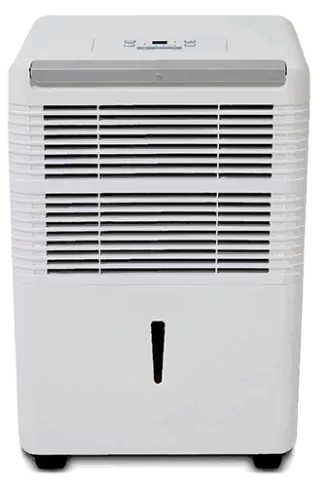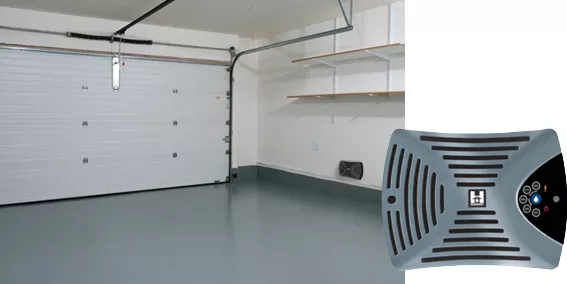You step into your garage for a little DIY or even a session at your home gym, and the air is hot and humid or cool and damp. Neither is very inviting. Even more disturbing, they can be the source of rust and corrosion or mold and mildew. These situations could arise in climates with hot and humid summers or in much colder areas near a large body of water. To combat the problem of humidity, here are some tips to reduce it in your garage, whatever season of the year.

Where does this humidity come from?
Here are some of the possible factors that could lead to high levels of garage humidity:
- Your garage isn’t insulated.
- Your garage door isn’t insulated or insufficiently weathertight.
- You store firewood there. Logs can contain a lot of moisture.
- You have installed your washer and/or dryer in the garage. Make sure the dryer's exhaust hose and dryer vent are working properly and are not obstructed.
- You keep various types of liquid in containers
- Your garage floor is sealed with an epoxy paint
- You keep cardboard boxes filled with things that you no longer use. Cardboard accumulates moisture and odors. Use plastic storage bins.
- You park your car in winter in the garage. Snow accumulates in the wheel wells and the underside of your car. The same is true in the summer if you bring your car in the garage after a heavy rain.
- You have a floor drain with a catch basin. It should be cleaned of sand, stones and debris regularly, but it will remain a source of humidity and possibly odors from standing water.
Once you have determined your different sources of humidity, you can easily measure the amount by placing a hygrometer in the garage for 24 hours. What is a good level to maintain a “comfortable garage”? Well, it will never be as low as inside the house, unless your garage is in a living space. If your garage is cool, be aware that overheating humid air will not help much ‑ that's uncomfortable for anyone!
Apart from a hygrometer, a simple way to check the humidity level in an insulated and weathertight garage is if you have a window installed on one of the garage walls, and you live in a cold area, look at the bottom of the window; if there is a small buildup of ice or considerable condensation, this is an obvious sign of higher humidity than normal.
Ways to reduce the amount of humidity
To start with, there are two basic elements that need to be in place if you want to adequately resolve your humidity problem. One is that your garage should be insulated. If it isn’t, it will be very difficult to reduce and maintain the level at one comfortable and acceptable for you. For those in cooler geographic regions, the only solution left is to heat your garage at the lowest possible cost, often wood heating.
The second element is your garage door, really your “fourth wall”. Is it insulated and properly weathertight? In this case, insulated means a garage door that provides a thermal resistance factor of at least R‑12. To achieve this, garage doors insulated with polyurethane foam injected between the door walls can give you this result. Another component to examine is weather seals. Is there effective exterior perimeter weatherstripping? Does it overlap the sides and the head of the door by at least 1 ½ inches? Does the bottom weatherstripping do its job by not letting rainwater into the garage? Does the threshold of the door correctly slope towards the outside of the garage? The goal is to identify possible entry points for humidity, both in summer and in winter.
In the list of factors for humidity we noted above, you now need to decide which you want to eliminate or tolerate as sources, and what level of humidity you are able to allow. The actions that will now be described in this blog assume that your garage as well as your garage door is insulated. If not, it would be useless to put the effort into making your garage comfortable.
Let’s start with basic measures. If you don’t use your garage very often for DIY or repair work, then about 45 minutes before you want to use it, turn off the heating system and open your garage door an inch or two to let the humidity out. If you have an access door or a window, open it also to create a draft. Any humidity will be able to escape faster. A small pedestal fan placed near the garage door can also speed up the job.
Another short‑term option: install a home dehumidifier. Run it at its maximum level for at least a full day. This should lower the humidity by 5 to 8 degrees.

As a long‑term measure for when you use your garage space more often, there are commercial dehumidifiers on the market which can be integrated into your current heating system. It will depend on how much you want to invest for the comfort you are looking for.

You can purchase a device, 9 X 6 ½ X 4 in. to vent humidity out of the garage via a duct in the wall.
What about a vent installed in the garage door? Is it effective? Actually, no, even if it has louvers to open and close. However, it is ideal for getting rid of odors.
Does this convince you to change your garage door?
Do you live in the Sault Ste. Marie area? If yes, then contact us now, toll‑free, at 1‑877‑794‑4223. Just tell us what situations you are dealing with and how you use your garage. We will advise you on the best choice to make while respecting your budget.
If you would like, we can email you a quotation. You can also come and meet us at our showroom. While you are deciding, why not try out our design centre to choose the door style that best suits you. Take a look at our image gallery for inspiring photos.









Add new comment